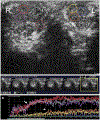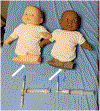Translational research in pediatric contrast-enhanced ultrasound
- PMID: 33991196
- PMCID: PMC11459366
- DOI: 10.1007/s00247-021-05095-8
Translational research in pediatric contrast-enhanced ultrasound
Abstract
The role of contrast-enhanced ultrasound (CEUS) imaging is being widely explored by various groups for its use in the pediatric population. Clinical implementation of new diagnostic or therapeutic techniques requires extensive and meticulous preclinical testing and evaluation. The impact of CEUS will be determined in part by the extent to which studies are oriented specifically toward a pediatric population. Rather than simply applying principles and techniques used in the adult population, these studies are expected to advance and augment preexisting knowledge with pediatric-specific information. To further develop this imaging modality for use in children, pediatric-focused preclinical research is essential. In this paper we describe the development and implementation of the pediatric-specific preclinical animal and phantom models that are being used to evaluate CEUS with the goal of clinical translation to children.
Keywords: Children; Contrast-enhanced ultrasound; Fetus; Neonates; Phantom; Translational research; Ultrasound; Ultrasound contrast agents.
© 2021. The Author(s), under exclusive licence to Springer-Verlag GmbH Germany, part of Springer Nature.
Conflict of interest statement
Figures










References
-
- Darge K (2010) Voiding urosonography with US contrast agent for the diagnosis of vesicoureteric reflux in children: an update. Pediatr Radiol 40:956–962 - PubMed
-
- Darge K, Moeller RT, Trusen A et al. (2005) Diagnosis of vesicoureteric reflux with low-dose contrast-enhanced harmonic ultrasound imaging. Pediatr Radiol 35:73–78 - PubMed
-
- Piskunowicz M, Kosiak W, Batko T et al. (2015) Safety of intravenous application of second-generation ultrasound contrast agent in children: prospective analysis. Ultrasound Med Biol 41:1095–1099 - PubMed
-
- Jacob J, Deganello A, Sellars ME et al. (2013) Contrast enhanced ultrasound (CEUS) characterization of grey-scale sonographic indeterminate focal liver lesions in pediatric practice. Ultraschall Med 34:529–540 - PubMed
Publication types
MeSH terms
Substances
Grants and funding
LinkOut - more resources
Full Text Sources
Other Literature Sources

